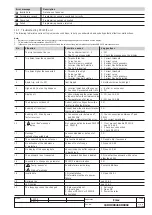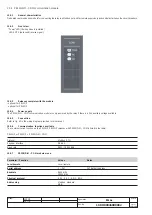
L2234
Emax
125/158
Model
Scale
Page No.
Doc. No.
Apparatus
1SDH000460R0002
L2778
16 Appendices
16.1 PR021/K outside signalling unit
16.1.1 General information
The signalling unit converts the digital signals provided by the protection units into electrical signals by means of normally-open electric contacts.
Information on the status of the protection functions transits on a dedicated serial line connected to the release.
The following signals/contacts are available:
- L overload prealarm (the alarm signal remains enabled throughout the overload, until the release has been tripped)
- protections timing and trip (the protections trip signal remains enabled during the timing-controlled phase and after the release has been tripped)
- I protection trip
- timing and overheating threshold overrun
- two contacts for load control
- release trip
- communication error on serial line (connections between protection and signalling units)
- phase unbalance.
By setting the DIP switches, you can configure the signals of 7 programmable contacts, This can be done by selecting them directly in the PR121
relay via PR010/T, SD-Testbus 2 or SD-Pocket; PR122/P or PR123/P relay, choosing from a long list, including: directional protection trip D, minimum
and maximum voltage trip UV and OV, reverse power trip RP and others.
Two contacts available on the SACE PR021/K (load control) unit enable you to control a release for opening and closing the circuit-breaker. These
contacts enable various applications, including load control, alarms, signals, electric cutouts.
A Reset button enables you to zero the status of all the front optical signals and return the relays' contacts to the resting position.
The unit also contains ten LEDs to display the following information:
- Power ON: auxiliary power supply on
- Tx(int Bus): flashing synchronized with dialogue with the Internal Bus
- Eight LEDs associated with the signaling contacts.
16.1.2
Power supply
Auxiliary power supply
24 V DC +/-20%
Maximum ripple
5%
Rated power @ 24 V
4.4 W
16.1.3
General characteristics of the signalling relays
The following data are defined for resistive loads (cos
ϕ
= 1)
16.1.4
Relay functions
The available contacts can be used to manage the respective relays indicating an event (a given situation in the state of the device) that prompts
the required relays to be independently enabled after the delay specified by the user. The function is entirely similar to the one described in the
PR120/K signalling module in par. 15.3 and 16.5 of this manual.
16.1.5
PR021/K signalling unit menu
The unit's functions are accessible from the operator panel (PR123/P and PR122/P where applicable)
Type of contact
SPST
Maximum switching voltage
130 VDC
380 VAC
Maximum switching current
5 A
8 A
Maximum switching power
175 W
2000 VA
Breaking capacity @ 35 VDC
5 A
----
Breaking capacity @ 120 VDC
0.2 A
----
Breaking capacity @ 250 VAC
----
8 A
Breaking capacity @ 380 VAC
----
5.2 A
Contact/coil insulation
4000 Veff
Contact/contact insulation
1000 Veff
1/8
Present
Relay n.1
Relay n.2
Presence
Local Bus Unit
1/4
None
Delay
NO / NC
Signal source
Relay n.1
Enter
↵
+ PWD
Enter
↵
4/4
Unit configuration
SIGNALLING Module
Local Bus Unit
COM Module
Modules














































